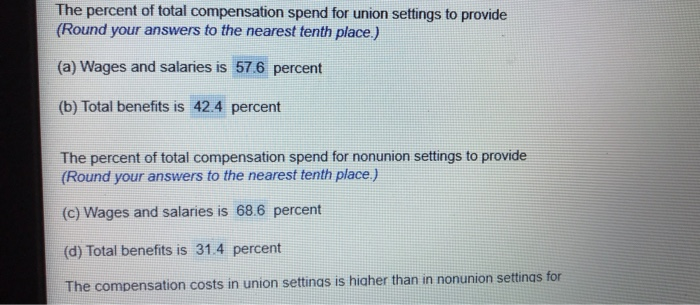Question Help Comparison of Compensation and Benefits Costs in Union and Nonunion Settings The management of nonunion companies strives to maintain nonunion status to keep employment costs low and to maintain tighter control over the terms of employment. It is against the law for companies to interfere with workers' attempts to unionice, however, companies that want to remain nonunion can adjust employment terms proactively to minimize workers interest in unioning As we discussed in this chapter text, companies may choose to offer higher compensation than they would otherwise in the absence of a union threat The following table shows hourly compensation costs for union and nonunion settings D Total compensation Total Wages and salaries Benefit costs Paid leave Supplemental Insurance Retirement Legally pay and savings required benefits Cost per hour worked 257 1.85 6.99 5.43 422 2.55 1.41 305 3.13 49.71 Union Nonunion 28 65 25.83 21.06 11.83 3765 The percent of total compensation spend for union settings to provide (Round your answers to the nearest tenth place.) (a) Wages and salaries is 57.6 percent (b) Total benefits is 42.4 percent The percent of total compensation spend for nonunion settings to provide (Round your answers to the nearest tenth place.) (c) Wages and salaries is 68.6 percent (d) Total benefits is 31.4 percent The compensation costs in union settings is higher than in nonunion settings for The compensation costs in union settings is higher than in nonunion settings for (Round your answers to the nearest hundredths place.) (a) Wages and salaries by 10.92 percent (b) Total benefits by 78.02 percent If nonunion companies pay 10 percent more, the amount they will pay to provide (Round your answers to the nearest hundredths place.) (c) paid leave benefit costs is $ 2.81 (d) supplemental pay benefit costs is $ 1.55 (e) insurance benefit costs is $ 3.36 (f) retirement and savings benefit costs is $ 1.86 (Note: Legally required benefits costs are largely outside the control of employers.) If costs were to increase by 5 percent in union settings, the new costs for (Round your answers to the nearest hundredths place) (a) wages and salaries is (b) total benefits is $ To maintain the 10 percent reduction in above situation, the amount nonunion companies spend on (Round your answers to the nearest hundredths place.) (c) wages and salaries is $ (d) total benefits is $










